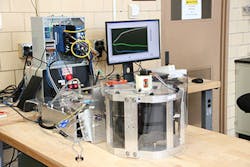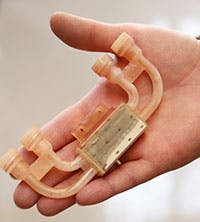Cooling Objects with Magnets
Researchers at the U.S. Department of Energy’s Ames Laboratory have designed and built an advanced device that uses small quantities of magnetocaloric materials to cool objects or inside enclosures level cooling. This marks an important step in creating technologies to replace 100-year-old gas compression refrigeration with solid-state devices that are up to 30% more energy efficient.
The device, dubbed CaloriSMART (Small Modular Advanced Research-scale Test-station) was designed to quickly evaluate materials in regenerators. The initial test subjected a sample of gadolinium to sequential magnetic fields, which caused the sample to alternate between heating up and cooling down. Using precisely timed pumps to circulate water during heating and cooling cycles, the device could sustain about 10 W of cooling power, with just under a 30° F (15° C) gradient between the hot and cold ends of the sample.
A device that uses alternating magnetic fields could be a rough prototype of solid-state refrigerators.
Magnetic refrigeration at near-room temperatures has been explored for 20 years, but this is one of the devices actually resulting from those efforts. It took roughly five months to build the device. The manifold that holds the sample and circulates the fluid that was made using 3D printing. The device also features customized neodymium-iron-boron magnets that deliver a concentrated 1.4 Tesla magnetic field to the gadolinium and the precision in-line pump that circulates the fluid.
The team will now explore other materials besides gadolinium and determine if the device can be scaled up for commercial cooling. But the main reason it constructed the device was to accelerate design and development of caloric materials so they can be moved to manufacturing in five to seven years, rather than the 20 years it typically takes.
A 3D-printed manifold holds the gadolinium sample that is subjected to alternating magnetic fields to generate cooling in the new device. The manifold also circulated water, which acted a thermal transport to remove heat.
The team also plan is to upgrade the device to work with elastocaloric materials which reversibly heat up and cool down when subjected to cyclic tension or compression, and electrocaloric materials which do the same when subjected to changing electric fields. The device should even operate in a combined-field mode that lets a combination of techniques be used simultaneously to cool things.



